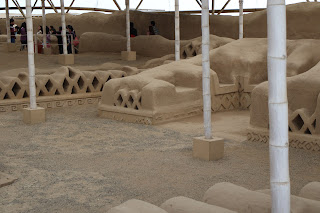Chan Chan, sometimes itself called Chimor, was the capital city of the Chimor kingdom. It was the largest city of the pre-Columbian era in South America. It is now an archeological site in the department of La Libertad five kilometers (3.1 mi) west of Trujillo, Peru.
Chan Chan is in a particularly arid section of the coastal desert of northern Peru. Due to the lack of rain in this area, the major source of nonsalted water for Chan Chan is in the form of rivers carrying surface runoff from the Andes. This runoff allows for control of land and water through irrigation systems.
The city of Chan Chan spanned 20 square kilometers (7.7 sq mi) and had a dense urban center of six square kilometers (2.3 sq mi) which contained extravagant ciudadelas. Ciudadelas were large architectural masterpieces which housed plazas, storerooms, and burial platforms for the royals. The splendor of these ciudadelas suggests their association with the royal class.
|
Plan of the walled compound Tschudi
|
Entrance (Plan No. 1)
|
Entrance to the walled compound Tschudi |
|
Walking towards the Main Square
|
Main Square (Plan No. 2)
|
Panorama of the Main Square |
|
Main Square
|
|
Scale model of the Main Square |
|
Decoration on the wall of the Main Square |
Bird and Fish Corridor (Plan No. 3)
|
Bird and Fish Corridor |
|
Fish
|
Small altar hall (Plan No. 4)
|
Panorama of the Small altar hall seen from the north |
|
Panorama of the Small altar hall seen from the south |
Audiences (Plan No. 5)
|
Panorama of the Audiences |
|
Audience of the pelican |
|
Audience of the wave and stepped motif |
|
Audience of the cross and stepped motif |
|
Audience of the peacock |
|
Audience of the Andean Cross |
|
Audience of the circle |
Ceremonial reservoir (Plan No. 7)
|
Panorama of the Ceremonial reservoir
|
Funeral platform (Plan No. 8)
|
Panorama of the Funeral platform |
See also
Source
Location









































































